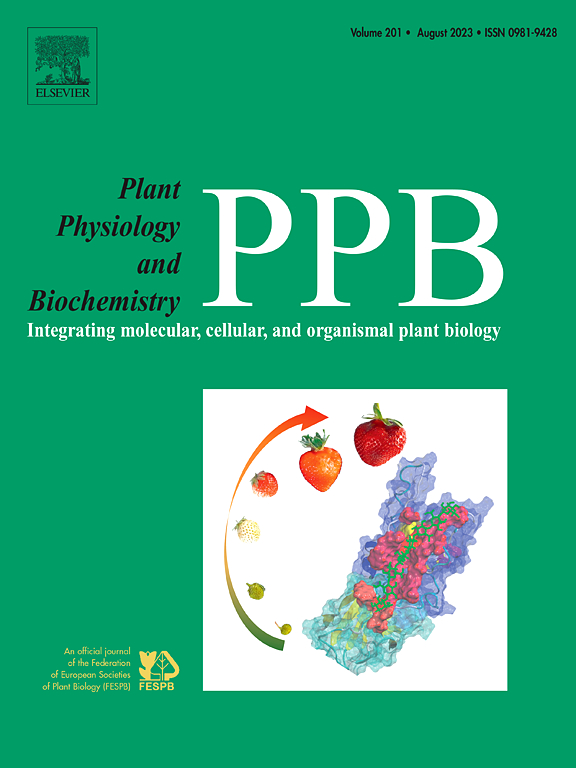Integrated genome-wide association and RNA sequencing analyses reveal key long noncoding RNAs and target genes for drought tolerance in wheat
IF 5.7
2区 生物学
Q1 PLANT SCIENCES
引用次数: 0
Abstract
Drought poses a major threat to global crop productivity, necessitating the identification of genetic components and regulatory networks underlying drought tolerance in wheat. Here, we integrated genome-wide association studies (GWAS) of 334 diverse wheat accessions with comparative transcriptomic analysis of drought-sensitive and drought-tolerant genotypes. GWAS identified 45 significant SNPs (−log10(p) > 3.5) and 281 candidate genes linked to seedling dry weight loss under drought stress. Transcriptome profiling revealed 821 differentially expressed genes, with co-expression network analysis uncovering 21 drought-responsive long noncoding RNAs (lncRNAs) and their target genes. These targets were enriched in ubiquitin-mediated protein degradation and transcriptional regulation pathways. Notably, lncRNA XR_006461531 was predicted to interact with TaFBX361—a gene co-identified by GWAS and RNA-seq—via a lncRNA-miRNA-mRNA interaction. Functional validation through virus-induced gene silencing (VIGS) demonstrated that knockdown of TaFBX361 significantly impaired plant growth and increased oxidative damage under drought, confirming its positive role in stress adaptation. Our findings reveal coordinated coding and noncoding regulatory modules governing drought responses in wheat, with TaFBX361 emerging as a promising genetic target for enhancing drought resilience. This study advances the molecular breeding toolkit by integrating multi-omics approaches to dissect complex traits, offering novel insights into lncRNA-mediated regulatory networks in crop abiotic stress tolerance.
综合全基因组关联和RNA测序分析揭示了小麦耐旱性的关键长链非编码RNA和靶基因
干旱对全球作物生产力构成重大威胁,有必要确定小麦耐旱性的遗传成分和调控网络。在此,我们将334个不同小麦材料的全基因组关联研究(GWAS)与干旱敏感和耐旱基因型的比较转录组分析相结合。GWAS鉴定出45个显著snp(−log10(p) >;3.5)和281个与干旱胁迫下幼苗干重下降相关的候选基因。转录组分析揭示了821个差异表达基因,共表达网络分析揭示了21个干旱响应长链非编码rna (lncRNAs)及其靶基因。这些靶点富含泛素介导的蛋白质降解和转录调控途径。值得注意的是,预计lncRNA XR_006461531将通过lncRNA- mirna - mrna相互作用与GWAS和rna -seq共同鉴定的TaFBX361-a基因相互作用。通过病毒诱导基因沉默(VIGS)的功能验证表明,TaFBX361的敲低显著损害了干旱条件下植物的生长和氧化损伤,证实了其在逆境适应中的积极作用。我们的研究结果揭示了调控小麦干旱响应的编码和非编码调控模块,其中TaFBX361有望成为提高小麦抗旱能力的遗传靶点。本研究通过整合多组学方法来解剖复杂性状,从而完善了分子育种工具,为lncrna介导的作物非生物胁迫抗性调控网络提供了新的见解。
本文章由计算机程序翻译,如有差异,请以英文原文为准。
求助全文
约1分钟内获得全文
求助全文
来源期刊
CiteScore
11.10
自引率
3.10%
发文量
410
审稿时长
33 days
期刊介绍:
Plant Physiology and Biochemistry publishes original theoretical, experimental and technical contributions in the various fields of plant physiology (biochemistry, physiology, structure, genetics, plant-microbe interactions, etc.) at diverse levels of integration (molecular, subcellular, cellular, organ, whole plant, environmental). Opinions expressed in the journal are the sole responsibility of the authors and publication does not imply the editors'' agreement.
Manuscripts describing molecular-genetic and/or gene expression data that are not integrated with biochemical analysis and/or actual measurements of plant physiological processes are not suitable for PPB. Also "Omics" studies (transcriptomics, proteomics, metabolomics, etc.) reporting descriptive analysis without an element of functional validation assays, will not be considered. Similarly, applied agronomic or phytochemical studies that generate no new, fundamental insights in plant physiological and/or biochemical processes are not suitable for publication in PPB.
Plant Physiology and Biochemistry publishes several types of articles: Reviews, Papers and Short Papers. Articles for Reviews are either invited by the editor or proposed by the authors for the editor''s prior agreement. Reviews should not exceed 40 typewritten pages and Short Papers no more than approximately 8 typewritten pages. The fundamental character of Plant Physiology and Biochemistry remains that of a journal for original results.

 求助内容:
求助内容: 应助结果提醒方式:
应助结果提醒方式:


